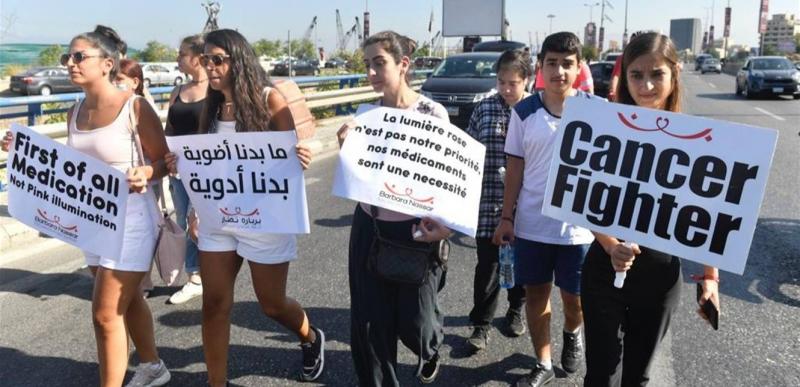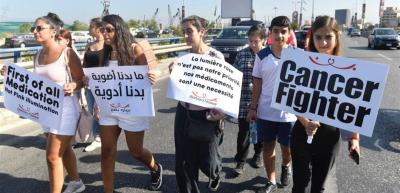Lebanon registered more than 33,500 cancer cases between 2017 and 2022, with about 40% of these, or 13,000 cases, being newly diagnosed in 2022 alone, while the number of deaths reached approximately 7,307 in the same year. Based on estimates from the cancer research agency of the World Health Organization, it becomes evident that for every 200 individuals residing in Lebanon, at least one person is diagnosed with cancer, and among every 400 individuals, one dies from cancer.
While these figures may seem shocking, they have roots in previous years, as Lebanon recorded about 17,000 new cancer cases and approximately 9,000 deaths in 2018, making it the country with the highest incidence of cancer in Western Asia relative to its population and the third highest in terms of cancer-related deaths relative to population.
These statistics are indeed extremely serious and have a shocking impact on many residents who are unable to access medication due to a decline in their incomes and widespread estimates suggesting a doubling in the number of cancer cases and a heightened risk of developing cancer due to increased air pollution resulting from the proliferation of electric generators following the exacerbation of the electricity crisis, in addition to deteriorating public safety and hygiene conditions due to austerity in public spending on the environment, waste management, health, and all matters related to social issues and human development for residents in Lebanon.
Air pollution is a primary contributing factor to the rise in cancer cases in Lebanon, particularly lung cancer, which constitutes 12% of all cases (ranking second after breast cancer) and is the leading cause of death from this disease, accounting for 19.3%. According to MP Najat Saliba, Executive Director of the Environmental Academy at the American University and supervisor of a study conducted by the American University of Beirut, air pollution in Beirut resulting from the spread of private generators has increased from 23% to between 46% and 50% between 2017 and 2023.
The study employs a comparative methodology between the years 2013 and 2023, focusing on air quality in three main areas of Beirut: Downtown Beirut, the vicinity of the American University, and the approach to Al-Maqasid in Tarik al-Jdideh.
Since the outbreak of the economic crisis in Lebanon in 2019 and the reduction of production from the Electricité du Liban to just a few hours a day, reliance on private diesel generators as the primary and nearly sole source of electricity has surged. According to Lebanese customs data, Lebanon imported electrical generators worth $83 million between 2019 and 2023, with the value of imports increasing from $8 million in 2020 to $21 million in 2023. Notably, the import of generators not exceeding 75 KVA significantly increased, from 6,772 generators to 14,548 between 2019 and 2023, with the peak recorded in 2022, which saw the liberation of energy prices and increased power cuts, during which Lebanon imported about 18,411 generators of this size.
The total number of small generators imported reached approximately 59,906 generators between 2019 and 2023, indicating consumers' reliance on small generators to meet their needs away from the restrictions of Electricité du Liban and neighborhood generators.
There is a concerning trend regarding the rise in cancer cases, not only in Lebanon but globally as well. According to estimates from the World Health Organization, about 20 million new cancer cases and approximately 9.7 million deaths were recorded in 2022, with projections of over 35 million new cancer cases expected in 2050, reflecting a 77% increase from 2022. Cancer incidence rates reflect people's exposure to risk factors, many of which are linked to social and economic development, with air pollution cited by the World Health Organization as a significant environmental risk factor.
The Lebanese Ministry of Health has ceased updating and publishing data on cancer rates in Lebanon since 2016. However, sources from the ministry indicated the allocation of approximately $19 million in 2022 for importing medications designated for cancer patients, averaging $560 per patient (assuming the number aligns with the World Health Organization's figures), while a study on the financial burdens of cancer treatment in Lebanon published in 2016 indicated that the annual cost of treating a single lung cancer case was approximately $5,260, exceeding the ministry's current provision by more than nine times and surpassing twice the current minimum annual wage in Lebanon. In total, the cost of cancer treatment at that time averaged $6,690 annually for each case. This significant disparity between the presumed treatment costs and what the Ministry of Health provides, alongside what individual incomes can afford, highlights the severity of the hardships faced by cancer patients in Lebanon.
Nonetheless, the economic burdens resulting from the rising number of cancer patients extend beyond the pharmaceutical and healthcare bills, even though those remain crucial and fundamental. In practical terms, cancer takes on a broader economic dimension that encompasses increased poverty, loss of income sources, and diminished productivity. The alarming aspect of the cancer situation in Lebanon is evident in the rising number of cases among the youth and adolescents who constitute an essential part of the workforce in the economy, according to numerous oncologists' testimonies.
It is known that the likelihood of developing cancer increases with age; however, for Lebanon, the World Health Organization estimates that the risk of developing cancer before the age of 75 was 17.3% in 2022. Although this percentage remains lower than the global average (20%), the risk of dying from cancer before the age of 75 is approximately 9.7%, exceeding the global average (9.6%). This reality reflects the diminishing capability to confront this illness, which is gradually declining due to rising treatment costs and deteriorating wage values amidst a near-total absence of public policies and declining health coverage from social security.




